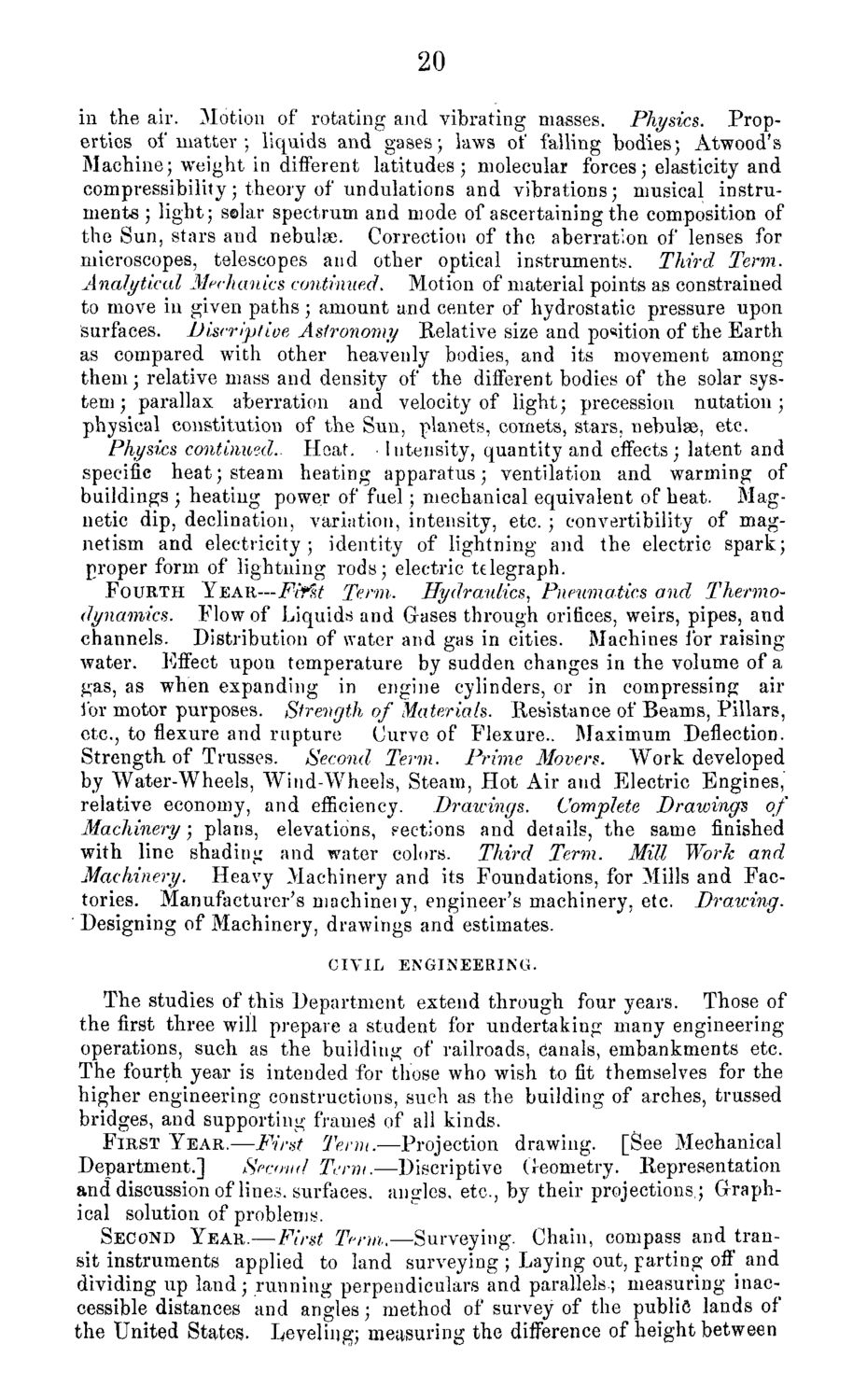| |
| |
Caption: Course Catalog - 1870-1871
This is a reduced-resolution page image for fast online browsing.

EXTRACTED TEXT FROM PAGE:
20 in the air. Motion of rotating and vibrating masses. Physics. Properties of matter ; liquids and gases; laws of falling bodies; Atwood's Machine; weight in different latitudes; molecular forces; elasticity and compressibility; theory of undulations and vibrations; musical instruments ; light; solar spectrum and mode of ascertaining the composition of the Sun, stars and nebula. Correction of the aberration of lenses for microscopes, telescopes and other optical instruments. Third Term. Analytical Mechanics continued. Motion of material points as constrained to move in given paths; amount and center of hydrostatic pressure upon surfaces. Discripiive Astronomy Relative size and position of the Earth as compared with other heavenly bodies, and its movement among them; relative mass and density of the different bodies of the solar system; parallax aberration and velocity of light; precession nutation; physical constitution of the Sun, planets, comets, stars, nebulse, etc. Physics continued.. Hoat. • Intensity, quantity and effects; latent and specific heat; steam heating apparatus; ventilation and warming of buildings ; heating power of fuel; mechanical equivalent of heat. Magnetic dip, declination, variation, intensity, etc. ; convertibility of magnetism and electricity; identity of lightning and the electric spark; proper form of lightning rods; electric telegraph. FOURTH YEAR—FcfUt Term. Hydraulics, Pneumatics and Thermodynamics. Flow of Liquids and Gases through orifices, weirs, pipes, and channels. Distribution of water and gas in cities. Machines for raising water. Effect upon temperature by sudden changes in the volume of a gas, as when expanding in engine cylinders, or in compressing air lor motor purposes. Strength of Materials. Resistance of Beams, Pillars, etc., to flexure and rupture Curve of Flexure.. Maximum Deflection. Strength of Trusses. Second Term. Prime Movers. Work developed by Water-Wheels, Wind-Wheels, Steam, Hot Air and Electric Engines, relative economy, and efficiency. Drawings. Complete Drawings of Machinery; plans, elevations, sections and details, the same finished with line shading and water colors. Third Term. Mill Work and Machinery. Heavy Machinery and its Foundations, for Mills and Factories. Manufacturer's niachineiy, engineer's machinery, etc. Drawing. ' Designing of Machinery, drawings and estimates. CIVIL ENGINEERING. The studies of this Department extend through four years. Those of the first three will prepare a student for undertaking many engineering operations, such as the building of railroads. Canals, embankments etc. The fourth year is intended for those who wish to fit themselves for the higher engineering constructions, such as the building of arches, trussed bridges, and supporting frames of all kinds. FIRST YEAR.—First Term.—Projection drawing. [See Mechanical Department.] Second Term.—Discriptive Geometry. Representation and discussion of lines, surfaces, angles, etc., by their projections,; Graphical solution of problems. SECOND YEAR.—First Term.—Surveying. Chain, compass and transit instruments applied to land surveying ; Laying out, parting ofi' and dividing up land; running perpendiculars and parallels-; measuring inaccessible distances and angles; method of survey of the public lands of the United States. Leveling; measuring the difference of height between
| |